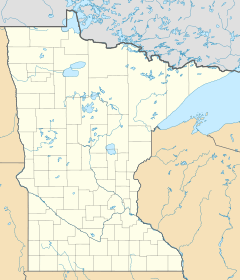Crooked Creek (Mississippi River tributary) facts for kids
Quick facts for kids Crooked Creek |
|
|---|---|
|
Mouth of Crooked Creek
|
|
| Country | United States |
| State | Minnesota |
| County | Cass County |
| Physical characteristics | |
| Main source | Crooked Lake 47°13′32″N 94°34′35″W / 47.2255556°N 94.5763889°W |
| River mouth | Steamboat Bay 47°14′13″N 94°34′31″W / 47.2368999°N 94.5752652°W |
| Length | 9.9-mile-long (15.9 km) |
| Basin features | |
| River system | Upper Mississippi River |
Crooked Creek is a small but important waterway in northwestern Minnesota, in the United States. It flows for about 9.9 miles (15.9 kilometers). This creek is a "tributary," which means it's like a smaller river that flows into a larger one. Crooked Creek eventually joins the mighty Mississippi River.
What is Crooked Creek?
Crooked Creek is a natural stream of fresh water. It is smaller than a river. Creeks often flow into larger rivers, lakes, or oceans. They are an important part of the Earth's water system.
Where Does Crooked Creek Flow?
Crooked Creek is located in Cass County, Minnesota. It starts its journey from a place called Crooked Lake. This lake is its "source." The creek then winds its way through the land.
After flowing for almost 10 miles, Crooked Creek reaches its end. It flows into Steamboat Bay. Steamboat Bay is part of a much larger body of water. This larger body of water is connected to the Upper Mississippi River.
Why Are Creeks Important?
Creeks like Crooked Creek play a big role in nature. They help move water from the land to larger rivers and lakes. This is part of the Earth's natural water cycle.
Creeks also provide homes for many plants and animals. Fish, insects, and other small creatures live in and around the water. Birds and larger animals visit creeks to drink water. They also find food there.
Protecting creeks helps keep our environment healthy. It ensures clean water for everyone. It also protects the homes of many different species.


